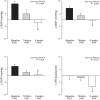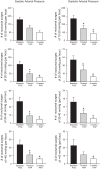Positive airway pressure improves nocturnal beat-to-beat blood pressure surges in obesity hypoventilation syndrome with obstructive sleep apnea
- PMID: 26818059
- PMCID: PMC4867377
- DOI: 10.1152/ajpregu.00516.2015
Positive airway pressure improves nocturnal beat-to-beat blood pressure surges in obesity hypoventilation syndrome with obstructive sleep apnea
Abstract
Positive airway pressure (PAP) treatment has been shown to have a modest effect on ambulatory blood pressure (BP) in patients with obstructive sleep apnea (OSA). However, there is a paucity of data on the effect of PAP therapy on rapid, yet significant, BP swings during sleep, particularly in obesity hypoventilation syndrome (OHS). The present study hypothesizes that PAP therapy will improve nocturnal BP on the first treatment night (titration PAP) in OHS patients with underlying OSA, and that these improvements will become more significant with 6 wk of PAP therapy. Seventeen adults (7 men, 10 women; age 50.4 ± 10.7 years, BMI 49.3 ± 2.4 kg/m(2)) with OHS and clinically diagnosed OSA participated in three overnight laboratory visits that included polysomnography and beat-to-beat BP monitoring via finger plethysmography. Six weeks of PAP therapy, but not titration PAP, lowered mean nocturnal BP. In contrast, when nocturnal beat-to-beat BPs were aggregated into bins consisting of at least three consecutive cardiac cycles with a >10 mmHg BP surge (i.e., Δ10-20, Δ20-30, Δ30-40, and Δ>40 mmHg), titration, and 6-wk PAP reduced the number of BP surges per hour (time × bin, P < 0.05). PAP adherence over the 6-wk period was significantly correlated to reductions in nocturnal systolic (r = 0.713, P = 0.001) and diastolic (r = 0.497, P = 0.043) BP surges. Despite these PAP-induced improvements in nocturnal beat-to-beat BP surges, 6 wk of PAP therapy did not alter daytime BP. In conclusion, PAP treatment reduces nocturnal beat-to-beat BP surges in OHS patients with underlying OSA, and this improvement in nocturnal BP regulation was greater in patients with higher PAP adherence.
Keywords: hypercapnia; hypertension; hypoxemia; sleep apnea.
Copyright © 2016 the American Physiological Society.
Figures




Similar articles
-
Diagnosing obstructive sleep apnea patients with isolated nocturnal hypoventilation and defining obesity hypoventilation syndrome using new European Respiratory Society classification criteria: an Indian perspective.Sleep Med. 2020 Feb;66:85-91. doi: 10.1016/j.sleep.2019.08.009. Epub 2019 Aug 29. Sleep Med. 2020. PMID: 31837626
-
Comparison between auto-trilevel and bilevel positive airway pressure ventilation for treatment of patients with concurrent obesity hypoventilation syndrome and obstructive sleep apnea syndrome.Sleep Breath. 2019 Sep;23(3):735-740. doi: 10.1007/s11325-018-1750-3. Epub 2018 Nov 13. Sleep Breath. 2019. PMID: 30426457
-
Obesity hypoventilation syndrome: hypoxemia during continuous positive airway pressure.Chest. 2007 Jun;131(6):1678-84. doi: 10.1378/chest.06-2447. Chest. 2007. PMID: 17565018
-
Noninvasive Ventilation versus CPAP as Initial Treatment of Obesity Hypoventilation Syndrome.Ann Am Thorac Soc. 2019 Oct;16(10):1295-1303. doi: 10.1513/AnnalsATS.201905-380OC. Ann Am Thorac Soc. 2019. PMID: 31365842
-
Obstructive Sleep Apnea, Obesity Hypoventilation Syndrome, and Pulmonary Hypertension: A State-of-the-Art Review.Sleep Med Clin. 2024 Jun;19(2):307-325. doi: 10.1016/j.jsmc.2024.02.009. Epub 2024 Mar 12. Sleep Med Clin. 2024. PMID: 38692755 Review.
Cited by
-
Looking Back on Seven Years of Regulatory, Integrative and Comparative Physiology.Am J Physiol Regul Integr Comp Physiol. 2020 Mar 1;318(3):R565-R566. doi: 10.1152/ajpregu.00017.2020. Epub 2020 Feb 12. Am J Physiol Regul Integr Comp Physiol. 2020. PMID: 32048873 Free PMC article. No abstract available.
-
Effect of varying chemoreflex stress on sympathetic neural recruitment strategies during apnea.J Neurophysiol. 2019 Oct 1;122(4):1386-1396. doi: 10.1152/jn.00319.2019. Epub 2019 Aug 7. J Neurophysiol. 2019. PMID: 31389742 Free PMC article.
-
Exosomal Cargo Properties, Endothelial Function and Treatment of Obesity Hypoventilation Syndrome: A Proof of Concept Study.J Clin Sleep Med. 2018 May 15;14(5):797-807. doi: 10.5664/jcsm.7110. J Clin Sleep Med. 2018. PMID: 29734990 Free PMC article.
-
Blood-pressure variability in patients with obstructive sleep apnea: current perspectives.Nat Sci Sleep. 2018 Aug 21;10:229-242. doi: 10.2147/NSS.S148543. eCollection 2018. Nat Sci Sleep. 2018. PMID: 30174467 Free PMC article. Review.
-
The Association Between Adherence to Positive Airway Pressure Therapy and Long-Term Outcomes in Patients With Obesity Hypoventilation Syndrome: A Prospective Observational Study.J Clin Sleep Med. 2018 Sep 15;14(9):1539-1550. doi: 10.5664/jcsm.7332. J Clin Sleep Med. 2018. PMID: 30176976 Free PMC article.
References
-
- Banerjee D, Yee BJ, Piper AJ, Zwillich CW, Grunstein RR. Obesity hypoventilation syndrome: hypoxemia during continuous positive airway pressure. Chest 131: 1678–1684, 2007. - PubMed
-
- Berry RB, Chediak A, Brown LK, Finder J, Gozal D, Iber C, Kushida CA, Morgenthaler T, Rowley JA, Davidson-Ward SL, NPPV Titration Task Force of the American Acadmey of Sleep Medicine. Best clinical practices for the sleep center adjustment of noninvasive positive pressure ventilation (NPPV) in stable chronic alveolar hypoventilation syndromes. J Clin Sleep Med 6: 491–509, 2010. - PMC - PubMed
-
- Bonsignore MR, Parati G, Insalaco G, Castiglioni P, Marrone O, Romano S, Salvaggio A, Mancia G, Bonsignore G, Di Rienzo M. Baroreflex control of heart rate during sleep in severe obstructive sleep apnoea: effects of acute CPAP. Eur Respir J 27: 128–135, 2006. - PubMed
-
- Bonsignore MR, Parati G, Insalaco G, Marrone O, Castiglioni P, Romano S, Di Rienzo M, Mancia G, Bonsignore G. Continuous positive airway pressure treatment improves baroreflex control of heart rate during sleep in severe obstructive sleep apnea syndrome. Am J Respir Crit Care Med 166: 279–286, 2002. - PubMed
Publication types
MeSH terms
Grants and funding
LinkOut - more resources
Full Text Sources
Other Literature Sources
Research Materials

